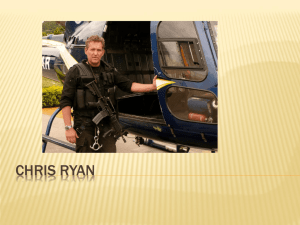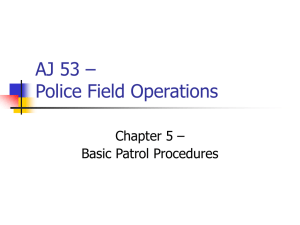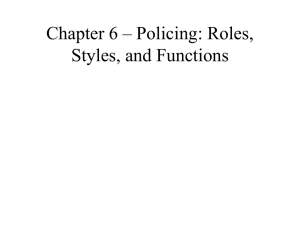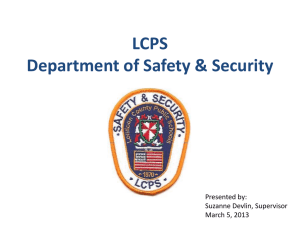Patrolling SCWS
advertisement
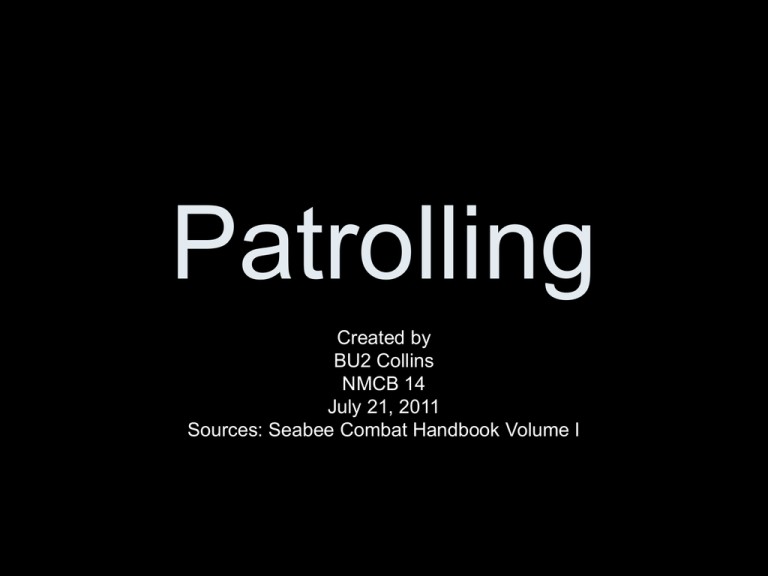
Patrolling Created by BU2 Collins NMCB 14 July 21, 2011 Sources: Seabee Combat Handbook Volume I Patrolling A patrol is a detachment of troops sent out from a larger body on a mission of combat, reconnaissance, security, or contact with friendly units. There are two general classes of patrols–reconnaissance and combat-either of which could have a mission of security. The classification is derived from the mission assigned to a patrol. Patrolling In the Seabees you are primarily concerned with defensive combat; security patrolling, rather than combat patrolling. The recon patrol is mainly used to detect enemy movement toward your position. You should be aggressive in your patrols to keep an accurate idea of what is in front of the FLOT. Recon Patrols Reconnaissance patrols are sent out to gain information about the enemy or the terrain. These patrols engage in combat only when it becomes necessary to accomplish their mission or to protect themselves. In general, they should avoid combat and accomplish their mission by stealth. Reconnaissance patrols have a variety of missions, but their primary mission is to obtain and report information in a timely manner to the commander who desires it. Recon Patrols A reconnaissance patrol might be dispatched to do the following: 1. Locate and observe the characteristics of a hostile position or installation 2. Reconnoiter a possible route of march for an enemy force. 3. Reconnoiter a certain terrain feature or the general nature of the terrain in a given locality. 4. Patrol the perimeter of the defense area in a static defense. Of primary importance is enemy troop buildup or movement and the type of weaponry in their possessions. Patrols Planning for a patrol is just as important if not more important than the patrol itself. The Patrol Leader must plan for every possible scenario that might happen. He must plan his route and any SOPs that the patrol will use. To aid in this process the Patrol Leader should use the 12 Steps to Planning a Patrol to make sure that no detail is left out. 12 STEPS TO PLANNING A PATROL • • • • • • • • • • • • S-study the mission P-plan the use of time S-study the terrain O-organize the patrol S-select men, weapons, and equipment I-issue the warning order C-coordinate M-make reconnaissance C-complete the detailed plan I-issue the Patrol Order S-supervise, inspect, rehearse, reinspect E-execute the order Study the Mission The Patrol Leader (PL) will receive a Patrol Order or Fragmentary Order (FRAGO) from higher. The PL will use this to plan the mission. Through studying of the mission, the terrain, and the situation, he identifies the essential tasks to be accomplished to execute the mission. These essential tasks become missions of the patrol’s elements and teams for which the organization, personnel, and equipment must be considered. Study the Mission At this time the PL should be gathering all the intelligence he can for the mission. To aid in this process the acronym METT-TC should be used so that no valuable information is missed. Study the Mission M-mission E-enemy (strength, equipment, activity, etc) T-time T-terrain and weather T-troops and fire support (Higher, Adjacent, Support) C-civilians Plan the Use of Time The first step in planning is to allot (approximately) the available time remaining before departure. When you fully understand the order, outline everything that must be done before you leave, and allot time for each item. Start with the time of departure and work backward. This procedure, tilled BACKWARD PLANNING, helps to ensure that you have allowed sufficient time for each necessary action. Make sure to include any rehearsals and planning into the time line. Study the Terrain Study the friendly and enemy situation closely for the effect that troop dispositions, strengths, and capabilities may have on your mission. These factors will influence the route you take, the size and organization of your patrol, and the weapons and equipment the patrol will carry. Study the map of the terrain over which the patrol intends to operate. The nature of the terrain in the vicinity of the objective will determine the number of security teams needed and the manner in which you will conduct your leader’s reconnaissance of the objective. KOCOA should be used to plan for terrian. Study the Terrain K-key terrain features O-observation/ fields of fire C-cover and concealment O-obstacles A-avenues of approach Organize the Patrol Organizing consists of determining the elements and teams required to accomplish the mission of the patrol. Organization of the patrol, either special or general, is given in the patrol warning order. Some of the teams that you may need is: support, point security, right/left security team, rear security team, aid and litter team, EPW, etc. The number of teams and personnel should be determined by the size of the mission. Select Personell, Weapons, and Equipment The patrol leader selects patrol members from the platoon or squad he commands. He should maintain the regular fire team or squad organization when possible. No man who may interfere with the mission should be included in the patrol. An example is a man with a cold. His coughing or sneezing could give the patrol away to the enemy. The number of personnel performing the patrol should be kept to the smallest number needed to accomplish the mission. This could be 2 men or a company. Care should be taken in choosing personnel to perform special functions within the patrol; such as Assistant Patrol Leader (APL), Radio Telephone Operator (RTO), Compass man, pace counter, point man, and any special personnel that the patrol may need. The PL should also appoint alternates for the RTO, compass man, and pace counter. Select Personell, Weapons, and Equipment The patrol takes along only those weapons absolutely necessary for mission accomplishment. Care should be taken to make sure that there is a couple of patrol members that can fix any weapon issues that may arise. The PL needs to make sure that all special weapons (machine guns, etc) have plenty of ammunition for the duration of the mission. All weapons need to be functioned checked prior to movement. If a new weapon or parts need to drawn from the armory now is the time. Select Personell, Weapons, and Equipment There are five categories of equipment that are usually required. They are as follows: 1. OBJECTIVE AREA equipment. This IS the equipment you need to accomplish the mission. It includes such items as weapons and ammunition, fiber line (small stuff) for binding prisoners, etc. 2. EN ROUTE equipment. This is equipment that assists or enables you to reach the objective. It includes such items as maps, compasses, binoculars, flashlights, wire cutters, and stream-crossing lines. 3. CONTROL equipment. This is equipment for maintaining communications and control. It includes telephones, whistles, pyrotechnics, flashlights, and luminous tape. The PL needs to make sure that any mechanical equipment (ie radios) works prior to movement and has plenty of extra parts (ie batteries). 4. WATER AND FOOD. Every man carries a canteen of water. On a long patrol, each man may carry two canteens plus rations to cover mealtimes during absence. For a very long patrol, arrangements must be made to resupply food and water. The patrol should carry supplies to last them for three days even if a resupply is scheduled. 5. ROUTINE equipment. This is the equipment patrol members carry. It includes the uniform and web equipment. Usually, each man carries a poncho and one extra pair of socks. Gloves should be worn, even in warm weather, to protect your hands from thorns, sharp rocks, and barbed wire. Issue the Warning Order To given individual patrol members maximum time to prepare, the patrol leader should issue a WARNING ORDER to ALL members as soon as possible after the patrol order is received. The Warning Order gives the who, what, where, when , why, and how of the mission. The Warning Order will be given in the form SMEAC. Issue the Warning Order 5 PARAGRAPH ORDER S-situation: Enemy forces, friendly forces, and attachments and detachments. M-mission: contains a concise statement of the mission, its purpose, and of the command as a whole. It includes “what,” “how,” “where,” and as much of “why” as maybe proper. E-execution: assigns definite tasks to each element of the command, organic and attached, that contributes to carrying out the overall mission. No restrictions are set on the number of subparagraphs. A-administration and logistics: this paragraph contains all the necessary information and instructions about supply, evacuation, hospitalization, transportation, service, personnel, and similar matters. C-command and signal: should contain references to the index of communications instructions (COI) currently in effect, instructions on the use of radio and pyrotechnics, and restrictions on the use of any means of communication. It should also include all radio signs, code words, countersigns, etc. Coordination In general, coordination means the arrangements made by other units to cooperate in the mission of the patrol. Examples would be: *Friendly units in which the patrol is operating so that the patrol is not caught in blue-on-blue contact. *Supporting fire (direct and indirect) may be needed by the patrol from friendly units. *Smoke cover, illumination, medivac, supply, etc may be needed by friendly units. Make Reconnaissance While the patrol is preparing for the mission, the leader should make a visual reconnaissance, when possible, to get information not available on the map. This should be an aerial reconnaissance, if possible, or a leaders reconnaissance. Check the route to be followed, noting prominent features of the terrain and any signs of enemy activity. When aerial reconnaissance is impossible, try to find a good location from which to observe the area or use maps and photographs from G-2 to make the reconnaissance. Complete Detailed Plan The specific duties of each element. The route of return and an ALTERNATE route incase of detection by the enemy. Patrol conduct, such as: the formation to maintain (wedge, column, or line) and the order of movement to follow, the points of departure from and reentry into friendly areas, the rallying points and the action(s) to take there, the action to take upon enemy contact, (immediate actions) the action to take in danger areas, and the action to take at the objective. Check to ensure that all the weapons, ammunition, and equipment specified in the warning order have been obtained. Determine the disposition to be made of friendly forces that are wounded and enemy prisoners. Signal system to use. Report system to follow. Challenge and password to use not only within the patrol but also in areas covered by other friendly units. Check to ensure that everybody has a place in the chain of command. Location of leaders-that is, where the leader plans to be in the formation and where the leader plans to station the assistant patrol leader. Issue of Patrol Order A patrol leader should issue orders in a clear, concise, and forceful reamer. Follow the standard operation order format. All patrol members should be present. The patrol leader precedes the order with a complete oral description of the plan and answers all questions after completing the order. The Patrol Order follows the SMEAC format. Supervise, Inspect, Rehearsal, and Re-inspect The patrol leader should hold a REHEARSAL of the mission, even if the patrol is thoroughly experienced. Before the rehearsal, the leader should hold an INSPECTION to determine the state of readiness, both physical and mental, of the men. The patrol leader must satisfy himself as to the completeness and correctness of uniform, weapons, and equipment. Then he will question the men to ensure that each man knows the following: The planned operations of the patrol. The part he will play. What others will do, insofar as their actions relate to him. All challenges, passwords, reporting times, and other significant details. A rehearsal improves the operational proficiency of the patrol and allows you to check the plans and to make needed changes. If the patrol is to operate at night, conduct both day and night rehearsals. When possible, use terrain similar to that over which you will operate. If time permits, rehearse all actions. Where time is limited, rehearse critical actions. Action at the objective is the most critical phase of the patrol and should always be rehearsed. Supervision is continuous by all patrol leaders throughout the planning, preparing, and completing of the patrol mission Execute the Mission The successful completion of a patrol is the end result of the continuing efforts of every patrol member, including yourself, who has earnestly applied knowledge, skills, and ingenuity to accomplish the mission. Some of the principles to follow in the conduct of your patrol and some of the techniques you may use are provided below. Remember, details vary with different circumstances. Formation A particular patrol formation. should provide for allaround security and good control. The formation chosen should be such that only a minimum number of men within the patrol are likely to be pinned down at any one time by surprise fire. Patrol formations must be fluid and flexible. They must be changed to meet varying terrain and visibility conditions. The patrol leader designates the original formation. Individual members then maintain assigned positions as long as they can see each other and, at the same time, make full use of available cover and concealment. Formation Column- Fast movement, good control, minimum fire to the front Wedge- Good control, all around security, high fire to the front and flanks Vee- Slow movement, good control, good security, high fire to the front Echelon- Slow movement, little control, high fire to front and flanks Line- Slow movement, little control, high fire to the front Order of Movement The order of movement should be kept the same during the entire patrol. Security should be kept to the front, sides, and rear at all times. This is your early warning system against enemy forces. The Patrol Headquarters (PL, RTO, compass man, and pace counter) should be near the front of the patrol to maximize command and control. The APL and the alternate RTO, compass man, and pace counter should be kept near the rear of the patrol in case the front should be ambushed and the Patrol HQ be killed or captured. Departure of Friendly Lines The PL should have coordinated with the unit whose lines he his crossing so that no friendly fire is encountered. The PL should go ahead of the patrol to make sure that the local leader is aware and that his troops are aware of your presence and intended actions. After passing through the lines the PL should halt his troops about 400 meters passed the FLOT to allow his troops a chance to get accustomed to their surroundings. No talking or actions should be taken at this time. This should act as your first Enroute Rally Point should you be attacked after leaving friendly lines. Rally Points A rallying point is a designated place where a patrol that has been dispersed can assemble and reorganize. It should provide cover, concealment, and be defensible for at least a short time. It must be easily recognizable and be known to all members of the patrol. There are three types of Rally Points that you will use: Initial, Enroute, and Objective. 1. INITIAL rallying point. This is a point within the friendly area where the patrol can rally if it becomes scattered before leaving the friendly area or before reaching the first tentative rallying point outside the friendly area. 2. EN ROUTE rallying point. This is a rallying point lying between the foremost friendly area and the objective. 3. OBJECTIVE rallying point. This is a rallying point near the objective where the patrol assembles after accomplishing the mission. The Rally Points should be designated during the planning phase so that all member know where they are located. At each rally Point the PL should halt the troops and either say, “This is a rally point.” or use a predetermined hand signal to let the patrol know that this area is a rally point. If the patrol should run into trouble and have to change course than what was planned the PL can form a Hasty Rally Point while on the move. At each Rally Point the PL should perform a head count as each member comes to the Rally Point to ensure that no one has been lost or that you have gained any enemy soldiers. Enemy Contact A patrol is subject to two types of enemy contact: (1) CHANCE contact and (2) AMBUSH. In chance contact, you come on the enemy unexpectedly, and the enemy is not prepared to deal with you. In ambush, you are subjected to an intentional surprise attack by an enemy that is concealed and lying in wait. The patrol should have an immediate action for all types of contact. Immediate Action Drills The PL should have a plan for every possible scenario that might occur based on the enemies capabilities. If the enemy has indirect fire support then there should be an action for contact with this type of fire. The patrol members must know what to do for any thing that might happen to avoid confusion on the battle field. Reentry into Friendly Lines After the mission has been completed the patrol must return through the FLOT. This may or may not be your own unit. The PL will halt the patrol in the last Rally Point and go ahead to contact the friendly unit leader to ensure the safe passage for the patrol. The PL needs to make sure that he has the correct password for the unit he is crossing. Other NATO nations or services may not be using the same password as your unit.

